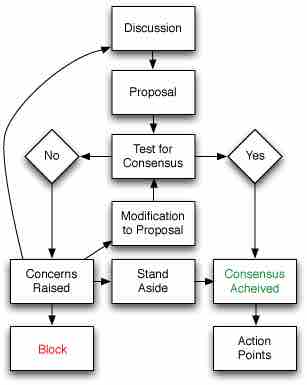Decision-making is the mental process resulting in the selection of a course of action among several alternative scenarios. Every decision-making process produces a final choice. Group decision-making is the process used when individuals are brought together in a group to solve problems. According to the idea of synergy, decisions made collectively tend to be more effective than decisions made by a single individual. However, there are situations in which the decisions made by a collection of individuals are riddled with error, or poor judgment. For example, groups high in cohesion have been noted to have a negative effect on group decision making and hence on group effectiveness.
Formal Systems for Making Decisions
Consensus decision-making tries to avoid "winners" and "losers". Consensus requires that a majority approve a given course of action, but that the minority agrees to go along with the course of action. In other words, if the minority opposes the course of action, consensus requires that the course of action be modified to remove objectionable features.
When a consensus is impossible, impractical, or undesirable, different voting systems can be used for a group to decide on an outcome. Three examples are range voting, majority voting, and plurality voting. Range voting lets each member score one or more of the available options. The option with the highest average is chosen. Majority voting requires support from more than 50% of the members of the group. Plurality voting is where the largest block in a group decides, even if it falls short of a majority.
Social Settings
Decision making in groups is sometimes examined separately as process and outcome. Groupthink is a psychological phenomenon that occurs within groups of people. It is the mode of thinking that happens when the desire for harmony in a decision-making group overrides a realistic appraisal of alternatives. Group members try to minimize conflict and reach a consensus decision without critical evaluation of alternative ideas or viewpoints.
Similarly, group polarization refers to the tendency for groups to make decisions that are more extreme than the initial inclination of its members. These more extreme decisions are towards greater risk if the individual's initial tendency is to be risky and towards greater caution if individual's initial tendency is to be cautious. In 2009, an interesting occurrence of group polarization was found in a study conducted by Luhan, Kocher, and Sutter, in which subjects played a ‘dictator game'. In this game, both individual and group decision-making was observed to see how individual preferences with respect to the allocation of money between a dictator and a recipient are transformed into a team decision. Their main finding was that team decisions were more selfish and competitive, less trusting and less altruistic than individual decisions. This study therefore offers evidence of group polarization, where the actions of individuals when in a group were more extreme than when the individual acted individually.

Consensus Decision-Making
This diagram shows how decisions are made by consensus. Consensus requires that a majority approve a given course of action, but that the minority agree to go along with the course of action.